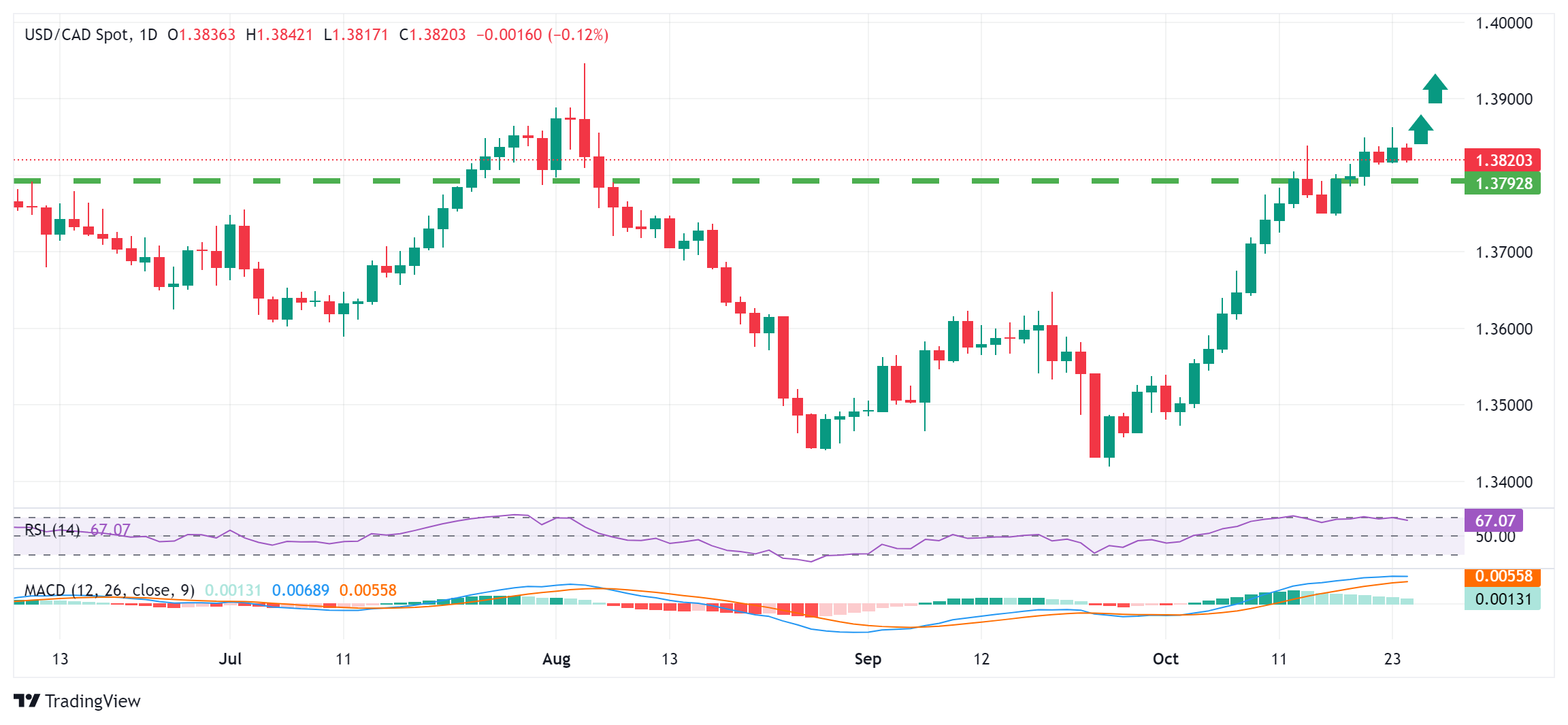- USD/CAD falls on Thursday and is pressured by a combination of factors.
- Rising oil prices benefit the CAD and weigh on the pair amid a weaker USD.
- The BoC rate cut and expectations of less aggressive Fed easing limit losses.
The USD/CAD pair attracts some sellers on Thursday and moves away from its highest level since early August, around the 1.3860-1.3865 region touched in reaction to the Bank of Canada (BoC) rate cut the previous day. The Canadian central bank took an aggressive step and decided to reduce its benchmark interest rate by 50 basis points (bps) for the first time since the COVID-19 pandemic. Furthermore, the recent drop in Canada’s annual inflation rate to 1.6% in September, along with signs that the economy and labor markets are weakening, paves the way for future aggressive rate cuts. This, in turn, weighed on the Canadian Dollar (USD) and provided a nice intraday boost to the currency pair.
That said, a fresh rally in crude oil prices, driven by lingering geopolitical risks stemming from ongoing conflicts in the Middle East, offers some support to the commodity-linked CAD. Apart from this, a modest pullback of the US Dollar (USD) from its highest level since July 30 touched on Wednesday, puts some downward pressure on the USD/CAD pair. US Treasury yields retreat from a three-month peak, which, coupled with stable performance in global stock markets, prompts some profit-taking around the safe-haven Dollar. That said, expectations of smaller rate cuts from the Federal Reserve (Fed) and concerns about deficit spending following the US election should limit the decline in US bond yields.
Investors remain concerned that the spending plans of both Vice President Kamala Harris and Republican candidate Donald Trump will further increase the deficit. In addition, the increasing likelihood that former President Donald Trump will win the US presidential election on November 5 is fueling speculation about the launch of possible inflation-causing tariffs. This could continue to push US bond yields higher and favor USD bulls, supporting prospects for some buying at lower levels around the USD/CAD pair. Traders now await the release of preliminary US PMIs. Apart from this, US bond yields will influence the USD, which, together with oil price dynamics, could create short trading opportunities. term.
Technical Perspective
From a technical perspective, a daily close above the 1.3800 level earlier this week was seen as a new trigger for the bulls. Furthermore, the oscillators on the daily chart remain comfortably in positive territory and suggest that the path of least resistance for the USD/CAD pair is to the upside. That said, the overnight failure to build momentum beyond the 1.3850 region warrants some caution before positioning for further gains. Acceptance above the said area could lift spot prices beyond the intervening hurdle of 1.3875, towards recovery of the 1.3900 level. The upward trajectory could further extend towards challenging the highest level since October 2022, around the 1.3945 region touched last month.
On the downside, weakness below the 1.3800 level could be seen as a buying opportunity. This should help limit the decline near last week’s low, around the 1.3750-1.3745 area. However, a convincing break below the latter could spark some technical selling and drag the USD/CAD pair further below the 1.3700 level, towards the test of the 100-day SMA, currently situated nearby. of the region of 1.3665. This is followed by the 200-day SMA, around the 1.3625 zone, which if broken, will negate the positive outlook and shift the short-term bias in favor of bearish traders.
USD/CAD daily chart
Source: Fx Street
I am Joshua Winder, a senior-level journalist and editor at World Stock Market. I specialize in covering news related to the stock market and economic trends. With more than 8 years of experience in this field, I have become an expert in financial reporting.








